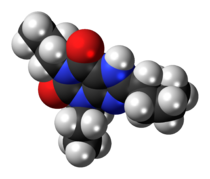 | |
 | |
| Clinical data | |
|---|---|
| ATC code |
|
| Legal status | |
| Legal status |
|
| Identifiers | |
| |
| CAS Number | |
| PubChem CID | |
| IUPHAR/BPS | |
| ChemSpider | |
| UNII | |
| ChEBI | |
| ChEMBL | |
| CompTox Dashboard (EPA) | |
| ECHA InfoCard | 100.162.425 |
| Chemical and physical data | |
| Formula | C16H24N4O2 |
| Molar mass | 304.394 g·mol−1 |
| 3D model (JSmol) | |
| Melting point | 191 to 194 °C (376 to 381 °F) |
| |
| |
| | |
8-Cyclopentyl-1,3-dipropylxanthine (DPCPX, PD-116,948) is a drug which acts as a potent and selective antagonist for the adenosine A1 receptor.[1][2] It has high selectivity for A1 over other adenosine receptor subtypes, but as with other xanthine derivatives DPCPX also acts as a phosphodiesterase inhibitor, and is almost as potent as rolipram at inhibiting PDE4.[3] It has been used to study the function of the adenosine A1 receptor in animals,[4][5] which has been found to be involved in several important functions such as regulation of breathing[6] and activity in various regions of the brain,[7][8] and DPCPX has also been shown to produce behavioural effects such as increasing the hallucinogen-appropriate responding produced by the 5-HT2A agonist DOI,[9] and the dopamine release induced by MDMA,[10] as well as having interactions with a range of anticonvulsant drugs.[11][12]
- ^ Martinson EA, Johnson RA, Wells JN (March 1987). "Potent adenosine receptor antagonists that are selective for the A1 receptor subtype". Molecular Pharmacology. 31 (3): 247–52. PMID 3561384.
- ^ Lohse MJ, Klotz KN, Lindenborn-Fotinos J, Reddington M, Schwabe U, Olsson RA (August 1987). "8-Cyclopentyl-1,3-dipropylxanthine (DPCPX)--a selective high affinity antagonist radioligand for A1 adenosine receptors". Naunyn-Schmiedeberg's Archives of Pharmacology. 336 (2): 204–10. doi:10.1007/BF00165806. PMID 2825043. S2CID 20549217.
- ^ Ukena D, Schudt C, Sybrecht GW (February 1993). "Adenosine receptor-blocking xanthines as inhibitors of phosphodiesterase isozymes". Biochemical Pharmacology. 45 (4): 847–51. doi:10.1016/0006-2952(93)90168-V. PMID 7680859.
- ^ Coates J, Sheehan MJ, Strong P (May 1994). "1,3-Dipropyl-8-cyclopentyl xanthine (DPCPX): a useful tool for pharmacologists and physiologists?". General Pharmacology. 25 (3): 387–94. doi:10.1016/0306-3623(94)90185-6. PMID 7926579.
- ^ Moro S, Gao ZG, Jacobson KA, Spalluto G (March 2006). "Progress in the pursuit of therapeutic adenosine receptor antagonists". Medicinal Research Reviews. 26 (2): 131–59. doi:10.1002/med.20048. PMC 9194718. PMID 16380972. S2CID 13758102.
- ^ Vandam RJ, Shields EJ, Kelty JD (2008). "Rhythm generation by the pre-Bötzinger complex in medullary slice and island preparations: effects of adenosine A(1) receptor activation". BMC Neuroscience. 9: 95. doi:10.1186/1471-2202-9-95. PMC 2567986. PMID 18826652.
- ^ Migita H, Kominami K, Higashida M, Maruyama R, Tuchida N, McDonald F, Shimada F, Sakurada K (October 2008). "Activation of adenosine A1 receptor-induced neural stem cell proliferation via MEK/ERK and Akt signaling pathways". Journal of Neuroscience Research. 86 (13): 2820–8. doi:10.1002/jnr.21742. PMID 18618669. S2CID 10240804.
- ^ Wu C, Wong T, Wu X, Sheppy E, Zhang L (February 2009). "Adenosine as an endogenous regulating factor of hippocampal sharp waves". Hippocampus. 19 (2): 205–20. doi:10.1002/hipo.20497. PMID 18785213. S2CID 2124092.
- ^ Marek GJ (March 2009). "Activation of adenosine(1) (A(1)) receptors suppresses head shakes induced by a serotonergic hallucinogen in rats". Neuropharmacology. 56 (8): 1082–7. doi:10.1016/j.neuropharm.2009.03.005. PMC 2706691. PMID 19324062.
- ^ Vanattou-Saïfoudine N, Gossen A, Harkin A (January 2011). "A role for adenosine A(1) receptor blockade in the ability of caffeine to promote MDMA "Ecstasy"-induced striatal dopamine release". European Journal of Pharmacology. 650 (1): 220–8. doi:10.1016/j.ejphar.2010.10.012. PMID 20951694.
- ^ De Sarro G, Donato Di Paola E, Falconi U, Ferreri G, De Sarro A (December 1996). "Repeated treatment with adenosine A1 receptor agonist and antagonist modifies the anticonvulsant properties of CPPene". European Journal of Pharmacology. 317 (2–3): 239–45. doi:10.1016/S0014-2999(96)00746-7. PMID 8997606.
- ^ Chwalczuk K, Rubaj A, Swiader M, Czuczwar SJ (2008). "[Influence of the antagonist of adenosine A1 receptors, 8-cyclopentyl-1 ,3-dipropylxanthine, upon the anticonvulsant activity of antiepileptic drugs in mice]". Przegla̧d Lekarski (in Polish). 65 (11): 759–63. PMID 19205356.